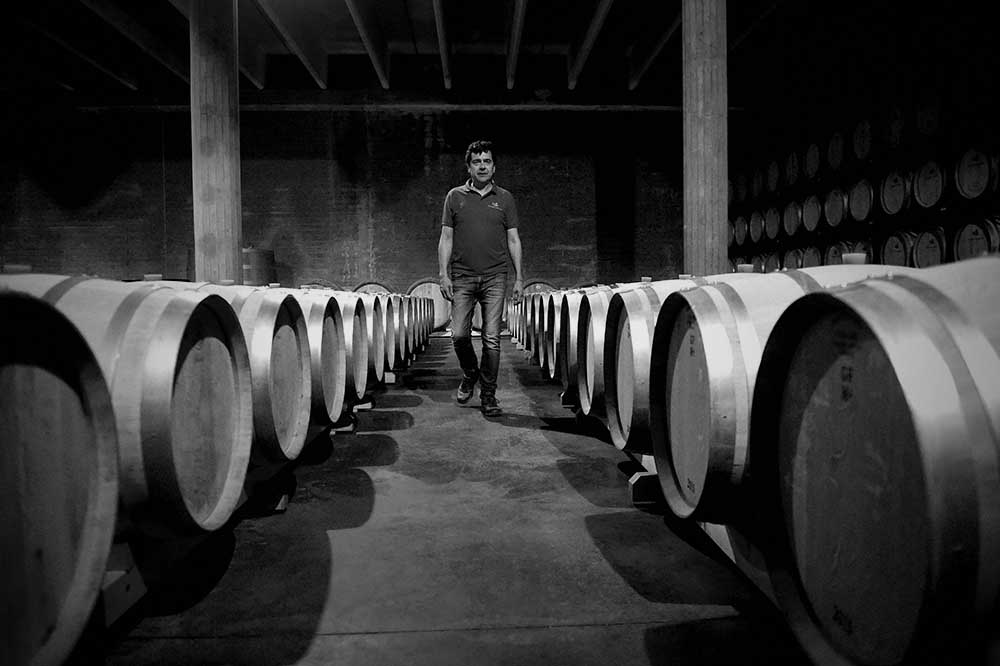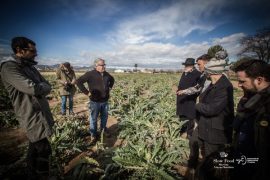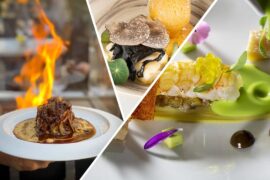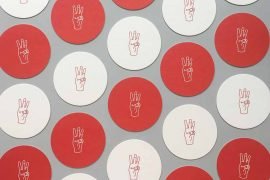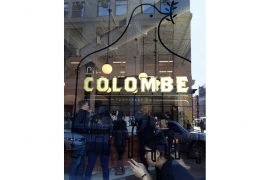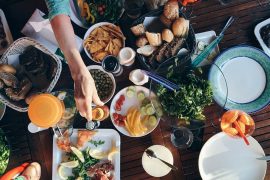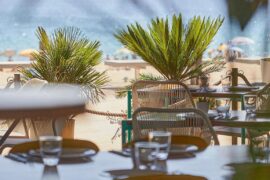[dropcap letter=”A”]
t first sight, he seems pretty conventional. But behind the commonplace image, there is an oenologist, an entrepreneur, the owner and overseer of one of Catalonia’s wine empires. Tomàs Cusiné makes very pondered wines, aspiring to furnish tables across the world with happiness and pleasure. He is responsible for four of the most influential wineries in the D.O. Designation of Origin—similar to the French Appellations—of Costers del Segre: Castell del Remei, , and Tomàs Cusiné; and one in Conca de Barberà: Cara Nord. The business student having fun in Barcelona has now become a business leader with a passion for wine and life, rooted in the midst of vineyards, but fleeting and enterprising as soon as routine imposes itself. He began in the world of wine almost by chance and decided to make it his way of life, through effort, talent and a good team, in a constant search for quality and differentiation. A vintner who would like to stay small, but who does not elude going big. We meet him at his Vilosell Wine Hotel, a place that offers bucolic and oenological experiences, to talk about his career of over three decades borne in an industry where he has been successful with almost everything he has tried his hand at. In addition, now, his wine ‘Cérvoles Blanc 2016’, has been chosen the best Catalan wine of 2018.
How did you first get mixed up with the world of wine? I guess it was not your priority when you were studying…
I didn’t study for a specific career in anything in particular… In 1982, my father bought the Castell del Remei property in Penelles, in the county of La Noguera in western Catalonia , where there were some dilapidated wineries, but it was not until 1985 when he decided to invest in the winery. I found myself right in the middle of things: at that time I was working as a mechanic, on farms, a bit of a Jack of all trades… and I just happened to be there when it all happened.
Dedicating your life to wine is a privilege for everyone who does so. The range of work you do during the year is very broad: you may be talking to a journalist, tilling the land, driving a tractor, tasting a good wine or sleeping in a good hotel. It is a very eclectic and very dynamic industry, with many opportunities. In short, it is a lifetime project that cannot be relocated. When you undertake a project of this nature you cannot move away from where you plant the seed, you can’t move away from the vineyard.
In the world of wine, either you export or you are nobody: At Castell del Remei I started exporting in 1991, we exported 70 percent of what we produced
Are you self-taught in the world of wine? How important are the consultants that you surround yourself with?
I have had teachers, people who have worked with me, and many advisers. I have learned from many years’ experience and from many other people who have accompanied me along the way. Businesses are made by people and in any industry, like the wine business, good people make companies rise and bad people make them fall. In the case of wine, the location, the brand associated with the location and the personal brand is also important. It is more difficult to succeed in an unknown region than in a renowned one. Building up a D.O. is a countrywide question, since behind it is territory, production, grape quality and the administrations.
Is ego a big issue in the wine industry? Are personal relationships a determining factor?
Yes and no. Those who really make great wines and know how to sell them will obviously be very satisfied and will be self-possessed. It’s only human. Within the world of wine all sorts of relationships are important: peer recognition is the most important of all. I much prefer a good critique from a wine producer to a good one by a journalist.
When did you take the decision to export? Your wines currently go to forty countries across five continents.
Either you export or you are nobody. In the world of wine you need to export more, especially from a place that is not well-known. At Castell del Remei I started exporting in 1991, we exported 70 percent of what we produced. Beginning in ‘92, exports grew considerably because the domestic market was not working. China is now fashionable as an emerging market, but we have been exporting to Hong Kong for 20 years now and have been developing the market there. This year, the Asian giant is very important for our production at Castell del Remei, but not for the other cellars.
Catalonia is one of the regions where there is the least domestic consumption. We are rather mercurial and we want to try a bit of everything
A lot of good wine is produced in Catalonia, but do people here buy the local wine?
Little by little, more and more. In fact, when we came to the market with Castell del Remei, in Lleida—the nearby provincial capital— it was very difficult to sell the product. Restaurant owners were not familiar with it and did not want to take the risk of stocking it. We grew alongside D.O. Costers del Segre and helped with the Catalan market. However, Catalonia is one of the regions where there is the least domestic consumption. We are rather mercurial and we want to try a bit of everything.
As far as wines go, the taste for Rioja still persists, but the time has come for Catalan wines and they now sell more than Rioja. This does not mean, however, that they sell more than the rest of the wines. 34% of Catalan wine consumption is for Catalan wines, and we should reach 50% in the next 5 years.
The time comes when you up the ante with higher quality wines by buying the Cérvoles winery. You say that it was a revelation. Are you still happy with the purchase, now that more than 20 years have gone by?
In 1997, at Castell del Remei we decided to stake on mountain vineyards and we started a project in La Pobla de Cérvoles. It’s 30 hectares—just over 74 acres— of vineyards with great possibilities, and between 1997 and 2003 I split my time between both wineries. We wanted to make mountain wines because they are more acidic, have a deeper colour and the wines are fuller-bodied.
But, in the middle of this business upheaval, you leave Castell del Remei and Cérvoles and establish Tomàs Cusiné. Do you get bored when things consolidate?
Routine is really boring. The beauty of projects is to start them and take them forwards, and when they they have grown after a few years, leave them to work on their own. We have had lots of fun for four years and since 2014 we have worked together on the four wineries, as we have redesigned a range of wines and every year we think about new things to do. We have taken a cellar that had grown old and we have rejuvenated it in every way.
I have been looking around for vineyards for 30 years, which means I know all of the vineyards above 500 meters—1640ft— in the province of Lleida. I started the project at Vilosell from scratch and I set up at the village cooperative. The idea was to make a small project that has grown.
But you missed Castell del Remei… and you went back!
I have always owned the Castell del Remei winery and I had a 49% stake, then 51% and when it was possible to bring everything together, we went back to working jointly.
Does each winery make wines targeting a specific audience?
I would rather say that each winery has a specific personality, but we have crossed audiences. All the wineries are at the same price level. I think that every consumer can find interesting wines at all four wineries.
Lately there has been a lot of talk of ecological, biodynamic wines… in some cases it is a fad. In your case it is a strategic line you have kept to, since 80% of the group’s vineyards now produce according to ecological criteria.
I believe that although today you can take the decision about whether to apply ecological criteria, in a few years it will be mandatory. I don’t think it is a differential value from the rest, since I just see it compulsory. I think that if you are not ecological you will end up losing sales. It doesn’t mean that if you are organic you will sell more, but rather, as I see it, it as a necessity. I like the idea of biodynamic production. I want to research it, try it out and get into it soon.
The quality of wine has grown a lot thanks to factors such as research, the oenologists and good products, and now it seems that there are no bad wines. Is that so?
There are no bad wines. The standard of oenology is high and even if you have a poor grape you can still make an acceptable wine. The difficulty is to differentiate within a context where the standard is getting higher and higher. There are concepts of all kinds involved: you might differentiate your product on an esoteric, natural, ecological level, etc. We make 1,200,000 bottles and how to differentiate them is a very complicated question that we ask ourselves every day. We work on being different, it is a constant search for quality: the day you think you have made the best possible wine, you’re screwed. Research and improvement is never over and you can never get to the best wine. The best wine does not exist: you may like one more than others. What is hardest is to sell dear, that’s where you differentiate.
With wine, what I hope to convey is a means of happiness, for people to have a good time drinking wine and enjoy it. Making something that gives pleasure is marvellous!
How do you manage to make your cellars profitable?
Profits do not come straight away, unless you have prior knowledge of the market. We have been making wine for 35 years, and for 25 we lost money. We didn’t break even at Tomàs Cusiné until two years ago. During that time you also build brand, heritage and added value. In the world of wine, you don’t get a return on the brand, you build it.
During the last few years you have also invested in converting the old Castell del Remei agricultural estate into a wine tourism centre. Is tourism a way to add value to the product and turn it into an experience?
We have wine tourism visits at Vilosell constantly, and at the Castell del Remei we have done it gradually. It has always been a rendezvous and a festive place for the region: it is already a historic landmark and it is thus easier to exploit.
What do you want to convey with your wines?
With wine, what I hope to convey is a means of happiness, for people to have a good time drinking wine and enjoy it. Making something that gives pleasure is marvellous! That people praise you for what you do is really satisfying, but we are also self-critical and know where we stand. We are aware of the size of our company in the world of wine, since making a million bottles does not make you a big producer if we compare ourselves with some cellars in Rioja, for example. I think we are on the right track, although I would rather be smaller. But if you build something and make it big, you’re not going to give it up, are you?!

